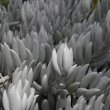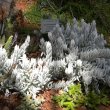Senecio haworthii
| Botanical Name | Senecio haworthii |
|||||||||||
| Family | Asteraceae - The daisy family. |
|||||||||||
| Pronunciation | sen-ek-ee-o hay-WOR-thee-eye |
|||||||||||
| Common Name(s) |
English: Woolly Senecio; Cocoon Plant
Afrikaans: Tontelbossie
|
|||||||||||
| Plant Group |
|
|||||||||||
| Plant Size |
|
|||||||||||
| Position |
|
|||||||||||
| General Information |
|
|||||||||||
| Specific Information | Senecio haworthii is a most attractive perennial succulent dwarf shrub, the 2 cm long cylindrical leaves being thickly covered with bright silvery-white hairs. The leaves are closely packed together up the stems giving it a column-like aspect. In cultivation the stems may reach 25 cm in height but are smaller in the veld due to the harsh conditions of their natural habitat. The thick hairy covering is an adaptation that allows the plant to survive in temperatures ranging from -6ºC up to, and even above, 40ºC, and is able to tolerate extreme periods of drought. A reference made in SANBI's PlantZAfrica site in 2002 quotes this plant as being threatened in its natural habitat, and in the 2008 assessment in SANBI's Red List of South African Plants, Senecio haworthii is categorised as being of Least Concern. Hopefully this means that the community has recovered. |
|||||||||||
| Ad Break | ||||||||||||
| Flowers | ||||||||||||
| Description | multiple tiny flowers held together in a head much like a paintbrush, at the end of a slender, unbranched stem 8 to 10 cm long |
|||||||||||
| Season |
|
|||||||||||
| Colour |
|
|||||||||||
| Growth Rate |
|
|||||||||||
| Plant Uses |
|
|||||||||||
| Distribution and Habitat | endemic to the Eastern Cape and Northern Cape, found in a few localities in the area known as the Nama Karoo biome, on rocky slopes near mountains, in gravelly or stony soil |
|||||||||||
| Planting Suggestions | Senecio Haworthii will survive in a variety of soils,but does best in sandy loam which must drain easily. It is happiest in full sun - shade and over watering will result in over-long, leggy stems with visible spaces between the leaves. This species is especially water shy and will rot if kept too wet. Water only when the soil is completely dry and reduce water to the merest dribble during the winter resting period. Plants are very easy to propagate by cuttings. Use healthy tip cuttings in early spring, allow the cut to dry for 2-3 days, and plant in coarse, sharp, river sand. Rooting will take place in a few weeks. |
|||||||||||
| Medicinal Uses | The white coating on the leaves was peeled off and used for tinder, hence the Afrikaans name 'Tontelbos' meaning 'tinderbush'. |
|||||||||||
| Ad Break | ||||||||||||






Discuss this plant
Share knowledge, ask a question or give an experience.